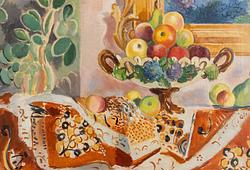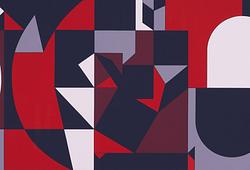Siri Rathsman
Untitled
Signed Siri Rathsman. Canvas 97 x 130 cm.
Provenance
Bukowski Auctions, Modern Art + Design 648, 16 May 2023, cat. no. 770.
Private collection, Berlin.
Stockholm Auction House Hamburg, "Art & Antiques", 10 June 2024.
Private collection, Stockholm.
More information
Siri Rathsman was one of the Swedish artists who early on sought out the continent and actively participated in the European avant-garde. Born in Sundsvall and educated at Carl Wilhelmson’s painting school as well as the Gothenburg Museum’s drawing and painting school, later Valand Academy of Art, she continued her studies in Copenhagen and Paris. At the Académie Moderne, she was taught by Raoul Dufy and Othon Friesz, and was strongly influenced by the early modernist experiments in color and form. During the 1920s, she worked in a neo-realist style, focusing on landscapes, interiors, and portraits, but gradually developed an increasingly non-figurative visual language with elements of Cubism and Surrealism.
From her studio in Paris, Rathsman wrote as a correspondent for Göteborgs Handels- och Sjöfarts-Tidning under the pseudonym Comtesse Belloni, and was part of the cultural and political core of Paris. During World War II, she reported from Vichy and was expelled in 1943 due to her outspoken articles—the same year she published the book Vichy förlorar spelet (Vichy Loses the Game), a sharp depiction of wartime France. In her painting, she simultaneously took a stand against the oppression of Nazism through a non-figurative expression that defied the censorship directed at modern art.
After the war, she returned to Paris, where her art was characterized by greater color richness and rhythmic freedom, often in the form of graphic prints and color lithographs. She exhibited regularly in Paris, Zurich, Brussels, London, Stockholm, and Gothenburg, among others alongside contemporaries such as André Masson and Maurice Estève. The retrospective exhibition at the Swedish-French Art Gallery in 1951, which showcased works spanning three decades, marked her artistic breakthrough in Sweden.
Siri Rathsman is represented in institutions such as the National Museum, Moderna Museet, Gothenburg Museum of Art, Malmö Art Museum, Kalmar Art Museum, and Norrköping Art Museum. Her art clearly reflects the intellectual and political engagement that defined her entire life—a testament to courage, freedom, and artistic integrity.

























































